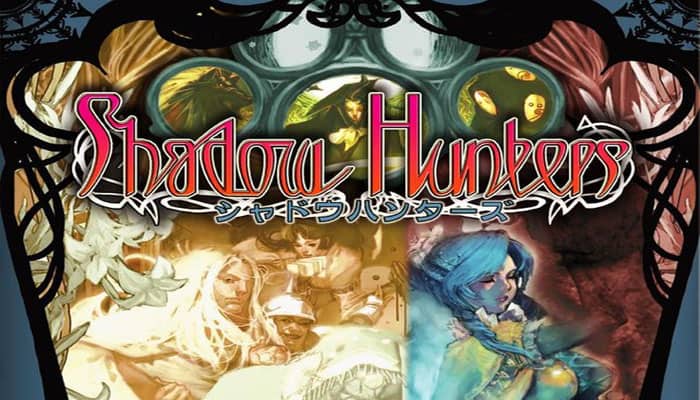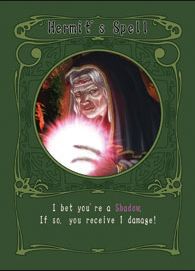
"Shadow Hunters" is a survival board game where three groups of characters, "Shadow", "Hunter" and "Neutral" (civilians) struggle against each other to survive.
The "Shadow" group are the dwellers in the demon world and the "Hunter" group's goal is to destroy all the "Shadow" group members.
Civilians are innocent people who happen to be in the middle of the battle. Each player assumes one character from one of these groups, but the other players will not know your identity.
You must determine who is your ally and defeat your enemies!
Components

- 1 Game board
- 6 Area cards
- 20 Character cards
- 16 Hermit cards
- 16 White cards
- 16 Black cards
- 8 Player boards
- 16 Wooden pieces
- 1 six-sided die and 1 four-sided die
- 1 Rule book
4 Players Setup Example:

Setup
The following preparations are necessary before you start playing the game. Note: the use of "players" and "characters" are interchangeable.
-
Place the Game Board in the center of the table and then randomly place the 6 Area Cards in pairs on the board. Each pair of Area Cards are in the same attack range of each other (see above).
-
Shuffle the White Cards, Black Cards and Hermit Cards separately and place them face down, outside the corresponding marked edge of the board.
-
Each player chooses his/her color and takes the two Wooden Pieces of that color, placing one in the "No Damage" circle on the Damage Track (called the "Hit Points - HP piece") and the other in front of them (called the "Player Piece").
This piece will be used to move about the Area Cards. Then each player takes a Player Board of their chosen color and places it in front of them. This Player Board will help identify which player controls which color Wooden Pieces.
-
Sort Character Cards into "Hunter", "Shadow" and "Neutral" decks and shuffle them separately with their backs facing up. Then refer to the "Character Cards Allocation List" and draw the appropriate number of cards from each group with their backs facing up.
Put all the drawn cards together, shuffle them one more time and then deal one to each player. Each player secretly checks his/her character identity and places the card on top of his/her Player Board with its back facing up.
Remember you can check your character identity anytime during the game. Make sure to put all the unused Character Cards aside so that no one knows which Character Cards have been dealt.
-
Randomly determine the starting player.
Character Cards Allocation List
- 4 players: 2 Hunter, 2 Shadow
- 5 players: 2 Hunter, 2 Shadow, 1 Neutral
- 6 players: 2 Hunter, 2 Shadow, 2 Neutral
- 7 players: 2 Hunter, 2 Shadow, 3 Neutral
- 8 players: 3 Hunter, 3 Shadow, 2 Neutral
Character Cards

Each Character Card has the following information.
A Name - Character name.
B HP (Hit Points) - This shows how much damage you can take before you die.
C Group Affiliation - This shows which group you belong to; "Shadow", "Hunter" or "Neutral" (civilians).
D Win Condition - This shows what condition your character must fulfill to win the game.
E Special Ability - Each character has its own unique ability. You can ignore them if you wish to play a simpler game.
Game Play
Each player plays the game clockwise in turns. When it is your turn, you do the following actions. This repeats until the game is over.
Move your character. (Mandatory)
Follow the instruction on the Area Card. (Optional)
Attack other player(s). (Optional)
Move Your Character (mandatory)

When it is your turn, you roll both dice at the same time. Add the two numbers and move your Player Piece to the Area Card of the same number. (On the 4-sided die, you always look at the top number to determine what was rolled).
If a total of 7 was rolled, you can move to any Area Card you like. Please note, however, you can not remain on the same Area Card. You must move each time you roll the dice. Roll again if you roll the same number of the Area Card you are on.
Example: A roll of 6puts you on the Church. If you are already on the Church, then roll again.
Action on the Area Card (Optional)
After you move, you may follow the instructions on the Area Card you're on. The following actions are available on the Area Cards.
Hermit's Cabin - Draw a card from the top of the Hermit Cards' stack and secretly read it. Then give it to another player of your choice.
Church - Draw a card from the top of the White Cards' stack and follow the instruction.
Cemetery - Draw a card from the top of Black Cards' stack and follow the instruction.
Underworld Gate - Choose one of three card stacks (White, Black or Hermit) and draw a card from the top of that stack. Then follow the instruction.
Weird Woods - Choose a player and do one of the following two actions:
- Give him/her 2 points of damage.
- Restore him/her 1 point of damage. (It is possible to choose yourself)
Erstwhile Altar - Steal an Equipment Card from a player of your choice. Nothing happens if no players have Equipment Cards.
Hermit Cards

Hermit Cards help you to identify the characters belonging to the other players. The player drawing the Hermit Card is the "current player".
If you draw a Hermit Card, read what's written on the card. Then choose a player and give the card to him/her while keeping the card's back facing up. (Don't let anyone else see the card).
Please note that it is the player who was given the Hermit Card who should follow the instruction, not the current turn player.
If you are given a Hermit Card, confirm what's written on the card and follow the instruction only if your character name or character affiliation matches the information on the card. Otherwise you declare "Nothing happens".
Hermit Card Example
You are given a Hermit Card which says: "I bet you're a Shadow!, If so, you receive 1 point of damage!" If your character's affiliation is Shadow, you get 1 point of damage and move your HP Piece up 1 space on the Damage Track.
If not, you do nothing and simply declare "Nothing happens".
The player who drew a Hermit Card and the player who was given the Hermit Card are not allowed to tell the other players what was written on the card. The player who was given the Hermit Card should place the card in the discard pile next to the Game Board face down.
If you are given a Hermit Card, you must not tell a lie and honestly follow the instruction on the card. (except if you are the character "Unknown")
If you run out of all the Hermit Cards, please shuffle the discarded Hermit Cards to create a new stack of cards.
White and Black Cards


There are two different types of White/Black cards as follows:
Single-use - If you draw a card which says "Single- use", you read the instruction to the other players, follow the instruction, and then discard it. Discarded cards are placed face up outside the opposite edge of the board where marked.
Equipment - If you draw a card which says "Equipment", you place the card in front of you face up. The card is then "activated". Equipment Cards are always in effect while activated. You can activate as many Equipment Cards as you like.
In case you run out of all the Black/White Cards, please shuffle the discarded cards to make a new stack of cards.
Attack Other Player(s) (optional)
At the end of your turn, you may attack a player on the 2 Area Cards in your range.
Range
When you move to an Area Card, you can choose to attack a player on either that card or the adjacent card it is paired with.
If you choose to attack, pick your target and roll both dice at the same time, inflicting damage equal to the difference between the two numbers rolled (subtract the smaller number from the bigger number). If both dice rolled have the same number, your attack fails and no damage is inflicted.
Example: If you roll a 2 on the 6-sided die and a 4 on the 4-sided die, you inflict 2 points of damage +(4 - 2 = 2).
In the case where you attack multiple players at one time due to certain card effects, you roll the dice once and apply the result to all the target players.
Character's Death
As you receive/heal damage from other players' attacks or card effects, you move your HP Piece on the Damage Track to record how much damage you've received (or healed). Your character dies when your accumulated damage equals or exceeds the HP amount shown on your Character Card.
When your character dies, you are out of the game. You must reveal your identity (turn your Character Card face up) and remove your Character Piece and HP Pieces from the Game Board.
If you kill another character, you obtain an Equipment Card of your choice from that character and discard the rest.
End of the Game
If you fulfill your character's Win Condition, you immediately reveal your identity (if not already revealed) and declare that the game is over. (In most cases this happens when a character dies).
You do not have to wait until your turn to declare the game is over. If your character fulfills its Win Condition due to another player's action, you may immediately declare that the game is over.
All the players who fulfilled their characters' Win Condition are considered to be winners.
Depending how the game progresses, it is possible for "Shadow" and "Hunter" players to end up as winners even if they have already been killed in the middle of the game.
Play Tips
Time Saving Rules
When played by 6 or more players, you may consider allowing each player to use a "Hermit Card" at the start of the game. This helps when most of the players are beginners or when you wish to keep play time short.
When the game's preparations are done, the starting player draws a Hermit Card. He/She does what it says on the card or says "Nothing happens" and then gives it to the player on his/her left, who does the same thing.
Handling of the Hermit Card is the same as in the standard rules.When all players are done using the Hermit Card, the game continues normally.
For Beginners
For the first game, you may choose not to allow Special Abilities to be used. In this case, REMOVE the character Bob from the game. This will simplify matters.
Identify other players' characters!
Identifying other players' characters is one of the biggest attractions of this game. If you attack other players without knowing their identity, you may end up attacking your allies.
Keeping close tabs on other players' actions should help you to figure out their identities.
Think about the team play!
Multiple players can be winners in this game. Even if the "Hunter" and "Shadow" group characters die in the middle of the game, they can still win the game if their ally player fulfills the Win Condition.
Therefore, when your character is about to die, it's important to see if there is anything you could do to put your ally player in an advantageous position.
Continue Reading
